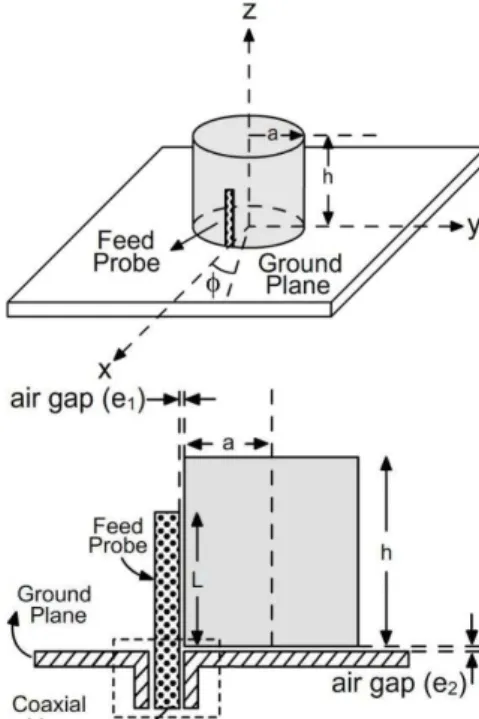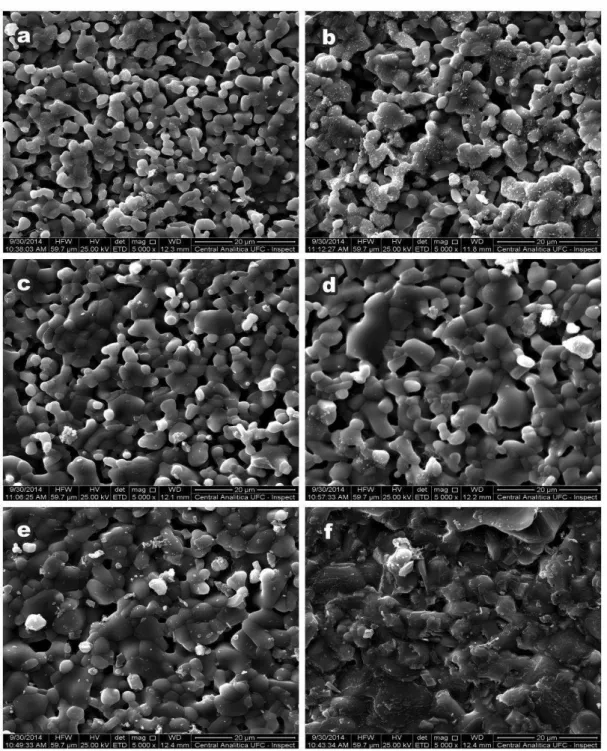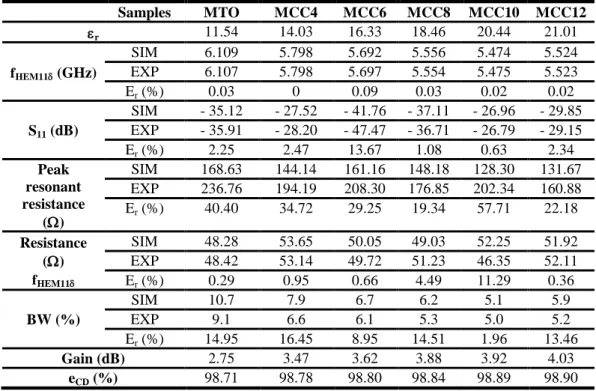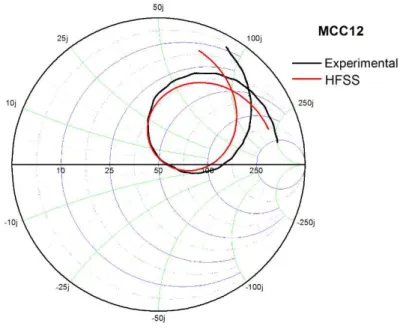Abstract— This paper describes an experimental and numerical investigation of the dielectric resonators based on the MgTiO3
ceramic matrix, which relates to their dielectric properties in microwave. The resonators are compounds of the MgTiO3 added
with 4, 6, 8, 10 and 12 wt% of the CaCu3Ti4O12. The manufacturing
process of the resonators is based on the solid-state method. The properties of the permittivity and dielectric loss are elucidated using the Hakki and Coleman´s method. The experimental measurements of the dielectric resonators, acting as antennas, provide some results as return loss, gain, efficiency, bandwidth and input impedance. These results are coherent with the numerical investigation. The addition of the perovskite CaCu3Ti4O12 in the
MgTiO3 ceramic matrix increased the value of the dielectric
constant and it was obtained a higher value of 21.01 for the sample MgTiO3 added with 12% CaCu3Ti4O12. The temperature coefficient
of resonant frequency (f) was measured for all the samples and the
best value obtained was 9.62 ppm/°C for the sample MgTiO3 added
with 12% CaCu3Ti4O12. The material duly proposed, shows to be
promising for applications as dielectric antennas and this study point out that it is possible to obtain a dielectric resonator antenna (DRA) with a temperature coefficient of resonant frequency close to zero.
Index Terms — MgTiO3, CaCu3Ti4O12, ceramic, composite, antennas, microwave properties.
I. INTRODUCTION
The Magnesium titanate (MgTiO3) ceramics, commonly called the MTO, is a popular dielectric
material applied in microwave frequencies. The MTO has the ilmenite type structure and applications in a microwave frequency range, it exhibits a good quality factor, a low dielectric constant and a temperature coefficient of resonant frequency τf∼−50 ppm/◦C [1]. The MTO is an attractive resonator
among microwave materials due to its promising dielectric properties, with moderately high values in quality factors, due to the low cost of raw materials. The MTO compound can also be used as an
Experimental and numerical
investigation of the microwave
dielectric properties of the MgTiO
3
ceramic matrix added with CaCu
3
Ti
4
O
12
P.W.S. Oliveira
a,b,c, G.F.M. Pires Junior
a,b,d, A.J.M. Sales
a,b, H.O. Rodrigues
a,b,eand A.S.B.
Sombra
a,baDepartamento de Engenharia de Teleinformática-UFC, Caixa Postal 6007, CEP 60755-640, Fortaleza, Ceará, Brazil b
Laboratório de Telecomunicações e Ciência e Engenharia dos Materiais (LOCEM), Caixa Postal 6030, CEP 60455-760, Fortaleza, Ceará, Brazil.
excellent electrical material employed in microwave components for the usage in radars, GPS and filters [5-6].
The main objective of the present study is to form a composite ceramic to optimize the performance of this particular material, thus, introducing a second phase with a high dielectric constant (>105), over a wide range of frequency, from -50 ºC to 300 ºC [2-3]. The CaCu3Ti4O12, ceramics commonly
called CCTO, is the subject of many studies in the literature associated with the synthesis and characterization of this said cubic perovskite, due to their unusual electrical properties. The CCTO ceramics is a promising material considering the subject of devices miniaturization to be used by the
electronics industry. Oxides with the perovskite structure are well stabilized by their high r values,
which allow this particular class of materials to be used in a large number of technological applications. The CCTO can also be used as a sensor for humidity, concentration of O2 and other
applications [4]. The CCTO is considered a good candidate due to its high dielectric constant and a
temperature coefficient of resonant frequency τf positive. Therefore, the composite MTO-CCTO has
thermal stability due near zero temperature coefficient of resonant frequency.
It is important to investigate the electrical behavior of the composite MTO-CCTO in the microwave (MW) range for their possible application as resonator antennas. On the flip side, as a general rule, the demands in the wireless mobile communications, has led to the development of antennas that are low
in profile and small in size. Dielectric resonator antennas (DRAs) have been extensively investigated
as suitable antennas for wireless applications [7-8]. The DRAs offer attractive features such as low
ohmic loss, low profile, small size and relatively wide impedance bandwidth. The DRAs can be used in millimeter frequency bands and being compatible with the existing excitation methods, such as the coaxial probe, microstrip transmission line, co-planar waveguide feed or the aperture coupling. The DRAs are available in basic shapes such as rectangular, cylindrical, spherical and hemispherical geometries.
The DRAs are miniaturized antennas of ceramics. They are fabricated entirely from low loss dielectric materials and being typically assembled on the ground planes. Their radiation characteristics are a function of the mode of operation excited in the DRA. This stated mode is generally chosen based upon the operational requirements. The resonators offer several advantages over other antennas, such as being of a small size with high radiation efficiency and being of
simplified coupling schemes for various transmission lines. The bandwidth can be controlled over a
The main properties required for a DRA are high quality factor (Q), high relative dielectric constant (r) and near zero temperature coefficient of resonant frequency (f). An optimal DRA that satisfies
these aforementioned three properties simultaneously is difficult to be achieved in a particular material [15]. Many efforts have been made to control the value of f in the dielectric materials
empirically in order to form solid solutions and homogeneous phases mixed with two or more combinations, which are values in the negative and the positive, in order to obtain a coefficient close to zero [16-17], which is required for commercial microwave applications. The mechanisms of the dielectric constant and the dielectric loss variations have been widely investigated.
In this particular investigation, we report the study of the dielectric constant and the dielectric loss of resonators, based on the MgTiO3 ceramic matrix added with the CaCu3Ti4O12, and the temperature
coefficient of resonant frequency (f) in this composite. The experimental and theoretical
characteristics of the resonator were properly investigated. The experimental results of the DRA, as introduced by Long and McAllister [7-8], and details of the numerical simulation using the Ansoft HFSS® are given and discussed herein.
II. EXPERIMENTAL PROCEDURE
A. Sample Preparation
The MgTiO3 (MTO) and the CaCu3Ti4O12 (CCTO) samples were prepared through the solid-state
reaction method, in exact accordance with the recent fabrication procedure [17]. The MTO sintered at 1200 ºC has higher porosity, as well as the dielectric constant below standard literature which show that the MTO was sintered at 1350 ºC [18]
Reagents and oxides were accurately weighed in stoichiometric amounts of the CaCO3 (Vetec,
99.0%), CuO (Vetec, 99.0%), TiO2(Vetec, 99.0%) and the MgO (Vetec, 99.0%). Previous to the first
heat treatment in the high-energy ball milling of the homogeneous powder mixture being conducted in a planetary ball mill for 6 h CCTO and 4h MTO, the rotation speed of the disks carrying the sealed vials was at 360 rpm. The compositions were then calcinated in conventional controlled furnaces at 1000 ºC (CCTO) for 6h and 1100 ºC (MTO) for 4 h, starting from room temperature with a speed of 5 ºC/min. After calcination, the CCTO (4, 6, 8, 10 and 12 wt%) was added to the MTO samples,
resulting in five different samples named MCC4, MCC6, MCC8, MCC10 and MCC12. The samples was pressed uniaxially (150 MPa) in a steel die, with a diameter of about 10 mm and a thickness of about 2 mm, hence, transforming the mixture into pellets. These pellets were sintered at 1200 ºC for 5 h in air.
B. X-ray diffraction
generator, X-ray optics, goniometer, X-ray detector and counting system, and recorder for data recording or storing. The powder samples were fixed on a silicon plate with a silicon paste. Patterns
were collected using CuK radiation, ( = 0.15418 nm), operated at 40 kV and 25 mA in the geometry of Bragg-Brentano, with a 0.02º (2 step size and a 2s count time, along angular range 20º - 80º (2θ)). The Rietveld´s method is successfully applied for determination of the quantitative phase abundances in the sintered specimen [19-20].
C. Microwave dielectric properties
The microwave dielectric properties were obtained using the Hakki and Coleman’s dielectric
resonant TE011 and TE01 methods [21]. The dielectric loss and dielectric constant were performed in
the frequency range of about 8.9–10.5 GHz using network analyzer Agilent N5230A. The values duly obtained in this experiment were used as guides in the numerical simulation of the antennas. The temperature coefficients of resonant frequencies (f) were measured in the temperature range of 22–80
ºC using a new method of measurement described in [22]. The f coefficient was calculated by the
following formula: 6 0 10 1 x T f f f
(ppm/ºC), (1)as f being the difference between the final and the initial frequencies, T being the difference between the final and initial temperatures and f0 is the resonance frequency in the beginning of the
process.
D. Resonator configuration
The measurements were performed in the transmission/reflection network analyzer, being Agilent N5230A. The DRAs are excited by a wire antenna above a ground plane. The scheme of the cylindrical DRAs is shown in Fig. 1. The DRA is placed above a conducting ground plane (the ground plane is made of copper, 355 mm x 300 mm x 2.14 mm), and excited by a coaxial probe. The coaxial probe went through the ground plane and was connected to an SMA connector. In Fig. 1, the
cylindrical DRA has radius a, height h and dielectric constant r of material. The probe was located on
the x-axis at x = a and = 0.
2 2 0 2 841 . 1 2 997 . 2 h a f r
Eq. (2) was obtained based upon the hypothesis that the lateral and the upper surfaces of the DRA being magnetic conductors perfectly. Since this assumption is verified only for the infinite dielectric constant, Eq. (2) is only an approximation that leads to an error around 10%.
Figure 1: The geometry of the cylindrical resonator antenna.
It would be interesting to compare the values issued from Eq. (2) to the following closed form expression for the HEM11 resonant frequency:
2 2 02 . 0 2 36 . 0 27 . 0 2 2 324 . 6 L a L a a c f r
(3)Using a curve fitting procedure on the numerical experiments based on the method of moments, the
Eq. (3) has duly been proposed by Kishk et al. [23] for r = 38, and has also been generalized by
Mongia and Bhartia [24]. It is important to note that both experimental and simulation results showed great variability in the results, according to the DRA distance to the probe. This particular challenge finds its origin in the presence of an air gap between the dielectric resonator and the metallic conductors, which have been thoroughly studied previously [26]. Furthermore, in order to illustrate the relevant effect, we defined in Fig. 1 two parameters associated with the air gap e1 between the
dielectric and the probe, and e2 between the dielectric and the ground plane.
E. S parameter
between the first and the second modes, at the resonant frequency of the f0, the resistance R would
show a maximum and the reactance X is null. This said behavior is illustrated in Fig. 5 for the Return Loss (S11). It must be stressed that the derivation of resonant frequencies from the minimum of the
return loss parameter S11 is not direct, as shown herein. The return loss S11 is related to Z by:
1 1
11
z z
S ;with
C
R Z
z (4)
as Rc is the characteristic impedance of the feeder. The Eq. (4) shows clearly that S11 depends on the
Rc: using an Rc = 50 feeder, it will be noted that the power transmission to the antenna is high (S11 0) in the resonant frequency of the DRA.
F. Numerical simulation
Another objective of this study is a numerical validation of the experimental set up, following the study of Kiang [27]. As a first advantage, one can investigate the influence of the probe in the resonant frequencies, once Eqs. (2) and (3) concern solely the DRAs without any probe. Secondly, the high sensitivity of the results as a function of the air gap confirms the HFSS® software providing the radiation pattern of these antennas.
An adaptive configuration of discretization was used and convergence is completed for a frequency variation that was inferior to 1%. An eigensolver was employed, in which the resonant frequencies of the structure presented in Fig. 1 were determined by an unexcited feeder along the boundaries of volume of air promoting the impedance matching through small adjustments. An analysis of the first mode in cartography showed that the field pattern inside the DRA was similar to the HEM11 mode of the probeless configuration. However, one can notice the existence of a strong
field in the probe vicinity, particularly on the interface with the DRA. This fact explains the high sensitivity of the DRA location, as well as discretization errors of the finite-element method.
Instead of the previous eigenmode analysis, the results presented in this study were issued from a harmonic analysis, where the feeder is excited. This stated method enables the determination of the port characteristics, such as the input impedance and the return loss. In order to take into account the effect of an air gap between the probe and the DRA, the gaps e1 and e2 (see Fig. 1) were estimated and
presented as one of the input parameters for the numerical simulation.
III. RESULT AND DISCUSSION
A. Structural analysis
obtained using the program DBWS9807a [28, 29] in Rietveld analysis of the X-ray powder diffraction patterns. Two main phases were observed and identified with the MTO-CCTO (see Fig. 3). The diffraction peaks presented by all samples were identified by the ICSD/95714 (CCTO) and the ICSD/55285 (MTO). Table 1 shows the refinement parameters S and Rwp, as well as the net parameters (a, b and c) for the DRX analysis through the Rietveld method of refinement for the samples.
Figure 2: single phase obtained with program DBWS9807a for Rietveld analysis of X-ray powder diffraction patterns of (a) CCTO(b) MCC12and (b) MTO ceramics sintered at 1200 ºC in air for 5 h: Yobs indicates the data of experiments. Ycalc
shows the data of calculation. Dif. shows the diference (Yobs - Ycalc).
Table 1: Rietveld Analysis for the samples of MTO-CCTO and MCC12 obtained from X-ray.
Refinement parameter Samples
MTO CCTO MCC12
R-WP 22.47 8.52 17.52
S 1.63 1.01 1.44
MTO CCTO
RBragg 5.29 3.29 8.76 8.44
% 100 100 89.20 10.80
Density (g/cm3) 3.895 5.055 3.895 5.055
a 5.055 7.391 5.055 7.391
b 5.055 7.391 5.055 7.391
Figure 3: X-ray diffraction patterns of MTO-CCTO samples, sintered at 1200 ºC/5 h
Figure 4: Microstructure of the sintered ceramics (a) MTO, (b) MCC4, (c) MCC6, (d) MCC8, (e) MCC10 and (f) MCC12.
B. Microwave dielectric properties
The dielectric loss (tg ) and the dielectric constant (r) duly obtained from the resonant frequency
of the TE011 mode in the Hakki and Coleman´s method are shown on Table 2. The dielectric constant
increased with the increasing addition of the CCTO and this is due to the decreased porosity and the
increased density, as well as the dielectric constant high of the CCTO (see Table 2). The dielectric loss decreases for the samples MCC4 and MCC6, when compared with the MTO. This is due to the
Concerning the MCC8, MCC10 and MCC12, the dielectric constant increase suggested greater
influence to the CCTO than to the composite.
Table 2: Microwave measurements of the samples obtained through the Hakki–Coleman (Courtney) method.
All the stated samples showed resonant frequency (f0) between 8.892 GHz and 10.527 GHz. The
highest dielectric constant was obtained for the MCC12 sample (r = 21.01) due to a higher
densification.
C. Studies of the MgTiO3– CaCu3Ti4O12 resonator antenna
Regarding the application in dielectric resonator antennas, it is necessary to have a combination with the dielectric constant, dielectric losses and temperature coefficient of the resonant frequency
(τf). The temperature coefficient of resonant frequency (f) for all samples is shown on Table 2. The τf
indicates how much the resonant frequency drifts with the changing temperature denoting the thermal stability of the material [14]. The sample MCC12 had the best value of the thermal stability (9.62 ppm/ºC) and presented good result for microwave applications, since f values were lower than 10
ppm/ºC, being necessary for these applications [14].
The frequency response around the first mode (HEM11) was determined by the HFSS ®
and the result is compared to one of the experiment. Hence, results properly obtained were reported for the input impedances, return loss, radiation patterns and the Smith Charts.
However, different resonant modes have distinct electromagnetic field distributions within the DRA and each mode may provide a different radiation pattern [22]. The mode with the lowest resonant frequency is the fundamental broadside HEM11.
The considerations herein related to the air gap between the probe, the resonator, and the ground plane carried out in this study, were essential to the improvement of the results through the numerical procedure. The values used in the simulation to the air gap (e1 and e2), influence the impedance
matching between the dielectric resonator and the transmission line. The adjustment of the magnitude in the return loss was also influenced by air gaps. Another critical parameter for the best fit of the experimental curve simulated, was adjusting the permittivity and the dielectric loss. The permittivity adjusted the positioning of the return loss curve in the frequency range and a dielectric loss have
Samples r F (ppm/ ºC)* tg f0 (GHz) (g/cm3) e1 (m) e2 (m) a (mm) h (mm)
MTO 11.54 -39.25 6.71 10.52 2.63 85 70 6.00 5.70
MCC4 14.03 -39.00 4.82 9.75 3.08 86 68 5.85 5.60
MCC6 16.33 -38.84 3.52 9.52 3.37 49 11 5.67 5.25
MCC8 18.86 -30.85 5.70 8.94 3.50 54 26 5.55 5.25
MCC10 20.44 -12.73 7.05 8.94 3.67 60 13 5.50 4.95
influence in the setting of bandwidth. On Table 3 and in Fig. 5, the theoretical and experimental results for the return loss (S11) of cylindrical antennas are shown, respectively.
Accordance between the experimental and the numerical results in the return loss do have good agreement (Fig. 5) and the error in the measured/simulated frequency is less than 0.1% for all samples. As for the value of the S11 the error is higher for MCC6 (13.67%) while the other samples
presented the error between 0.4% and 2.5% (see Table 3).
Table 3: Theoretical/experimental frequencies and air-gaps assigned for numerical procedures of cylindrical antennas
Such a behavior has been explained in literature [25; 26]. The resistance R of the first resonant frequency of each antenna was also indicated on Table 3 and in Fig. 8. The best compromise between the experimental and simulated resistance occurred in the sample MCC8 (19.34%).
In order to get a more precise behavior, the complex S11 was reported in the Smith Chart for the
MCC12 in Fig. 7. Regarding the other five dielectric samples, the Smith Chart was quite similar. Usually, it was noticed that a good agreement was obtained between the simulation with the HFSS® modeling and the experimental methodology, which verified the effectiveness of DRAs modeling
using the Ansoft’s HFSS®
.
Samples MTO MCC4 MCC6 MCC8 MCC10 MCC12
r 11.54 14.03 16.33 18.46 20.44 21.01
fHEM11(GHz)
SIM 6.109 5.798 5.692 5.556 5.474 5.524 EXP 6.107 5.798 5.697 5.554 5.475 5.523
Er (%) 0.03 0 0.09 0.03 0.02 0.02
S11 (dB)
SIM - 35.12 - 27.52 - 41.76 - 37.11 - 26.96 - 29.85 EXP - 35.91 - 28.20 - 47.47 - 36.71 - 26.79 - 29.15 Er (%) 2.25 2.47 13.67 1.08 0.63 2.34 Peak
resonant resistance
()
SIM 168.63 144.14 161.16 148.18 128.30 131.67 EXP 236.76 194.19 208.30 176.85 202.34 160.88 Er (%) 40.40 34.72 29.25 19.34 57.71 22.18 Resistance
()
fHEM11
SIM 48.28 53.65 50.05 49.03 52.25 51.92 EXP 48.42 53.14 49.72 51.23 46.35 52.11 Er (%) 0.29 0.95 0.66 4.49 11.29 0.36 BW (%)
SIM 10.7 7.9 6.7 6.2 5.1 5.9
EXP 9.1 6.6 6.1 5.3 5.0 5.2
Er (%) 14.95 16.45 8.95 14.51 1.96 13.46
Gain (dB) 2.75 3.47 3.62 3.88 3.92 4.03
Figure 5: Experimental and theoretical HFSS Return loss (S11) of cylindrical resonators (a) MTO, (b) MCC4, (c) MCC6, (d) MCC8, (e) MCC10 and (f) MCC12.
The agreement between the experimental and the theoretical value is good. However, one can notice as well that the minimum of |S11| was not situated in the null reactance curve of the Smith Chart
(Fig. 7). Therefore, Z is not real at f0, as the graphic of Z, given in Fig. 6. For this stated reason, the
Figure 6 Experimental and theoretical HFSS input impedance (Z) of cylindrical resonators (a) MTO, (b) MCC4, (c) MCC6, (d) MCC8, (e) MCC10 and (f) MCC12.
The aforesaid calculated radiation pattern of the E plane and the E plane in the resonant frequency of the MTO samples, are shown in Fig. 8. Regarding the other five dielectric samples, the radiation pattern was quite similar. The symmetries of the field patterns were related to the feed probe location
at ( = 0º) and the duly obtained values for the x–z plane (Fig. 8) showed a broad and almost an
Figure 7: Experimental and theoretical HFSS input impedance Smith Chart of cylindrical resonators of MCC12.
Figure 8: Simulated radiation pattern of E ( = 0º), E ( = 90º) and E ( = 0º) of MTO.
The gain of an antenna is defined as “the ratio of intensity in a given direction in relation to the radiation intensity that was duly properly obtained, if the power accepted by the antenna was radiated
isotropically” [30; 31]. With a little amount of the CCTO doped into the MTO, there was a gain increase from the 2,75 dB (pure MTO) to the 4,03 dB (MCC12) (see Table 3).
IV. CONCLUSIONS
This study describes an experimental and numerical investigation of the dielectric properties in microwave of the ceramic resonators matrix, based on the MgTiO3. The materials were obtained from
Ansoft’s HFSS®
. An Excellent agreement between the simulation and the experimental results, was duly obtained. The MgTiO3 ceramic matrix presents a dielectric constant between 11.54 and 21.01.
The antenna bandwidth was in the range of 5.0 and 9.1%. The temperature coefficient of resonant frequency (f) from the MTO showed values in the range of -39.25 ppm ºC
-1
to 9.62 ppm ºC-1. The sample of the MCC12 has value of the thermal stability of 9.62 ppm/ºC and permissivity of 21.01 as well as dielectric loss of 8.62 x 10-4. The result is in good agreement for the microwave applications. In summary, the performance in the microwave region of the dielectric ceramic cylindrical samples based in the MgTiO3, confirms the potential use of such said materials for the small DRAs.
V. ACKNOWLEDGMENTS
The authors thank the LOCEM (Laboratory of Telecommunications and Materials Science and Engineering), the Departments of Physics and Teleprocessing, the x-ray laboratory of the Federal University of Ceará, Brazil, and Central Analytical Department of the Federal University of Ceará.
REFERENCES
[1] C. L. Huang, C. H. Shen, C. L. Pan, Materials Science and Engineering B 145, Elsevier, pp. 91–96, 2007.
[2] P. Lunkenheimer, V. Bobnar, A. V. Pronin, A. I. Ritus, A. A. Volkov, and A. Loidl, Phys. Rev. B, vol. 66, no. 052105, 2002.
[3] M. H. Cohen, J. B. Neaton, L. X. He, and D. Vanderbilt, J. Appl. Phys., vol. 94, no. 5, pp. 3299–306, 2003.
[4] M. Li, X. L. Chen, D. F. Zhang, W. Y. Wang, and W. J. Wang, Sens. Actuators B-Chem., vol. 147, no. 2, pp. 447–52, 2010.
[5] J. Y. Chen and C. L. Huang, Mater. Lett., vol. 64, no. 23, pp. 2585–8, 2010.
[6] H. Jantunen, R. Rautioaho, A. Uusimaki, and S. Leppavuori, J. Eur. Ceram. Soc., vol. 20, no. 14–15, pp. 2331–6, 2000. [7] M.W. McAllister, S.A. Long, G.L. Conway, IEEE Electron. Lett., vol. 19, no. 6, pp. 218–219, 1983.
[8] S.A. Long, M.W. McAllister, L.C. Shen, “The resonant cylindrical dielectric cavity antenna”, IEEE Trans. Antennas Propag. AP-31, no. 3, pp. 406–412, 1983.
[9] A. Petosa, A. Ittipiboon, Y. Antar, “Dielectric Resonator Antennas, Research Studies”, Press Ltd., Hertfordshire, England, UK, 2003, pp. 177–208.
[10]K.M. Luk, K.W. “Leung, Dielectric Resonator Antennas, Research Studies”, Press Ltd., Hertfordshire, England, UK, 2003.
[11]D. Pozar, “Microwave Engineering”, John Wiley & Sons, Inc., 1998.
[12]D. Kajfez, A. W. Glisson and J. James, IEEE Trans. Microwave Theory Tech., vol.MTT-32, pp. 1609-1616, 1984. [13]Y. Kobayashi and S. Tanaka, IEEE Trans. Microwave Theory and Tech., vol. 28, pp. 1077-1085, Oct. 1980. [14]M.T Sebastian, “Dielectric Materials for Wireless Communication”, Elsevier, 2008.
[15]A.D.S.B. Costa, D.G. Sousa, R.C.S. Costa, F.W.de O. Amarante, T.S.M. Fernandes, G.D. Saraiva, M.A.S. da Silva, A.S.B. Sombra, Phys. Scr., vol. 84, 2011.
[16]H.O. Rodrigues, A.J.M. Sales, G.F.M. Pires Junior, J.S. Almeida, M.A.S. Silva, A.S.B. Sombra, J. Alloys Compd, vol. 576, pp. 324–331, 2013.
[17]H.O. Rodrigues, G.F.M. Pires Junior, J.S. Almeida, E.O. Sancho, A.C. Ferreira, M.A.S. Silva, A.S.B. Sombra, J. Phys. Chem. Solids, vol. 71, pp. 1329–1336, 2010.
[18]J. Bernard, F. Belnou, D. Houivet, J. M. Haussonne, “Low sintering temperature of MgTiO3 for type I capacitors”.,
Journal of the European Ceramic Society, vol. 25, pp. 2779–2783, 2005. [19]H.M. Rietveld, Acta Crystallography, vol. 22, pp. 151, 1967.
[20]H.M. Rietveld, J. Appl. Crystallography, vol. 2, pp. 65, 1969.
[21]B.W. Hakki, P.D. Coleman, “A dielectric resonator method of measuring inductive capacities in the millimeter range”,
IRE Trans. Microw. Theory Tech. MTT-8, pp. 402–410, 1960.
[22]M.A.S. Silva, T.S.M. Fernandes, A.S.B. Sombra, J. Appl. Phys. vol. 112, no. 074106, 2012.[Online]. Available: http://dx.doi.org/10.1063/1.4755799.
[23]A.A. Kishk, A.W. Glisson, D. Kajfez. “Computed Resonant Frequency and Far Fields of Isolated Disks”, IEEE AP-S International Symposium Digest, vol. 1, pp. 408–411, 1993.
[24]R.K. Mongia, P. Bhartia, Int. J. Microw. Millimeter-Wave Computer-Aided Eng., vol. 4, no.3, pp. 230–247, 1994. [25]G.P. Junker, A.A. Kishk, A.W. Glisson, D. Kajfez, IEEE Electron. Lett., vol. 30, no. 2, pp. 97–98, 1994.
[27]J.F. Kiang, “Novel Technologies for Microwave and Millimeter Wave Applications”, Kluwer Academic Publishers, Boston, 2004.
[28]Bleicher L, Sasaki JM, Santos COP. “Development of a graphical interface for the Rietveld refinement program DBWS”. J Appl Crystallography, vol. 33, no. 4, pp. 1189, 2000.
[29]Young RA, Sakthivel A, Moss TS, Paiva-Santos “CO. DBWS-9411–an upgrade of the DBWS*.* programs for Rietveld refinement with PC and mainframe computers”. J Appl Crystallography, vol. 28, no. 3, pp. 366–367, 1995 [30]Z. Peng, F. Wang, X. Yao, Ceram. Int., vol. 30, pp. 1211–1214, 2004.
[31]E. Carvalho, M. Bertolete, I. F. Machado, E. N. S. Muccillo. “Characterization of the perovskite CaCu3Ti4O12








